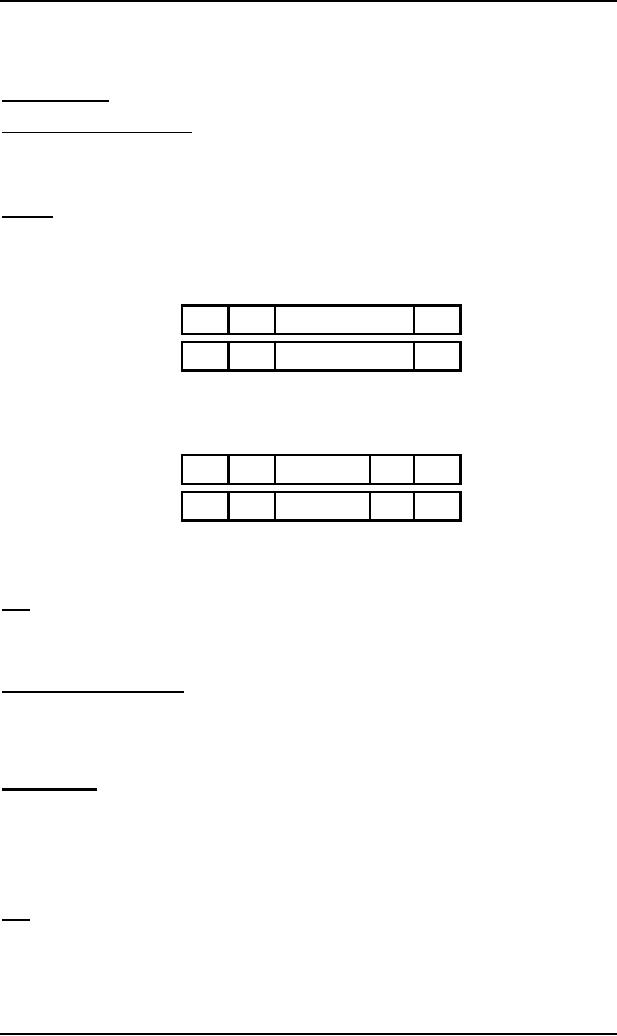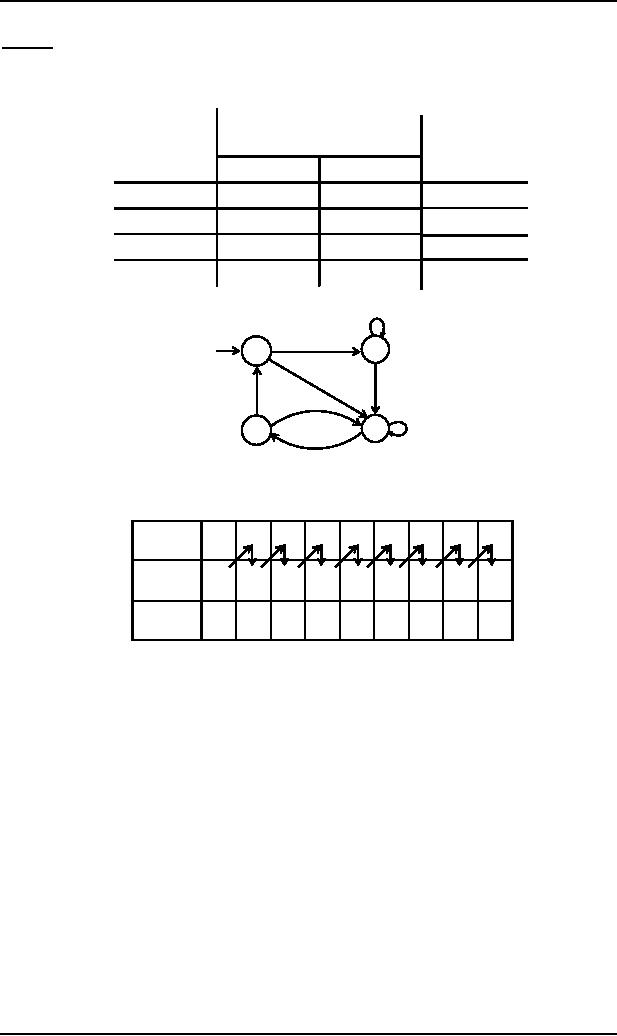 |
Finite Automaton with output, Moore machine |
| << Distinguishable strings and Indistinguishable strings |
| Mealy machine >> |

Theory of
Automata
(CS402)
Theory of
Automata
Lecture
N0. 20
Reading
Material
Introduction
to Computer Theory
Chapter
8
Summary
Example
of previous Theorem, Finite Automaton
with output, Moore machine,
Examples
Example
Let
L20={w OE {0,1}*: |w| ≥ 20 and
the 20th
letter of w, from
right is, 1}. Let S be
the set of all strings of
length
20,
defined over Σ, any
two of which are distinguishable
w.r.t.
L20. Obviously the number of
strings belonging
to S, is 220. Let x and y be any two
distinct strings i.e.
they
differ in ith letter, i=1,2,3,...20,
from left. For
i=1,
they
differ by first letter from
left.
Then by
definition of L20, one
is in L20 while other is not as shown
below
0
.
...
.
1
.
...
.
So they
are distinct w.r.t. L20 for z = L i.e.
one of xz
and yz belongs to L20.
Similarly
if i=2 they differ by 2nd letter from left and
are again distinguishable and hence
for z belonging to Σ*,
|z|=1,
either xz or yz belongs to L20 because in this case
the 20th
letter from
the right of xz and yz is
exactly the
2nd letter from left of x and y
as shown below
z
0
.
...
.
...
z
1
.
.
Hence x
and y will be distinguishable w.r.t. L20 for i=2, as well.
Continuing the process it
can be shown that any
pair of
strings x and y belonging to S,
will be distinguishable w.r.t. L20. Since S contains 220 strings, any two
of
which
are distinguishable w.r.t. L20, so using the theorem any
FA accepting L20
must
have at least 220 states.
Note
It may be
observed from the above
example that using Martin's
method, there exists an FA
having
220+1-1=2,097,151 states.
This indicates the memory
required to recognize L20 will be the memory of a
computer
that
can accommodate 21-bits i.e.the
computer can be in 221 possible states.
Finite
Automaton with output
Finite
automaton discussed so far, is
just associated with the RE
or the language.
There is
a question whether does there
exist an FA which generates an output
string corresponding to each input
string ?
The answer is yes. Such
machines are called machines
with output.
There
are two types of machines
with output. Moore machine
and Mealy machine
Moore
machine
A Moore
machine consists of the
following
A finite
set of states q0, q1, q2, ... where q0 is the initial
state.
An
alphabet of letters Σ =
{a,b,c,...} from which the
input strings are
formed.
An
alphabet G={x,y,z,...}
of output characters from which output
strings are
generated.
A transition
table that shows for
each state and each
input letter what state is
entered the next.
An output
table that shows what
character is printed by each
state as it is entered.
Note
It is to be
noted that since in Moore
machine no state is designated to be a
final state, so there is no
question of
accepting
any language by Moore machine.
However in some cases the
relation between an input string
and the
corresponding output
string may be identified by the
Moore machine. Moreover, the
state to be initial is not
important
as if the machine is used several
times and is restarted after
some time, the machine
will be started
from
the state where it was left
off. Following are the
examples
60

Theory of
Automata
(CS402)
Example
Consider
the following Moore machine
having the states q0, q1, q2, q3 where q0 is the start
state and
Σ =
{a,b},
G={0,1}
the
transition table follows as
New
States after reading
Characters
Old
States
to be
printed
a
b
1
q0-
q1
q3
0
q1
q3
q1
q2
q0
q3
0
1
q3
q3
q2
the
transition diagram corresponding to the previous
transition table may be
b
a
q1/0
q0/1
b
a
a
b
a
q3/1
q2/0
b
It is to be
noted that the states
are labeled along with the
characters to be printed. Running the
string abbabbba
over
the above machine, the
corresponding output string will be 100010101, which
can be determined by the
following
table as well
a
b
b
a
b
b
b
a
Input
q0
q0
q1
q1
q1
q3
q2
q3
q2
State
1
0
0
0
1
0
1
0
1
output
It may be
noted that the length of output string is
l more than that of input
string as the initial state prints out
the
extra
character 1, before the
input string is read.
61
Table of Contents:
- What does automata mean, Introduction to languages
- Kleene Star Closure, Recursive definition of languages
- Regular Expression, Recursive definition of Regular Expression
- Equivalent Regular Expressions
- Finite Automaton
- Equivalent FAs
- FA corresponding to finite languages
- Examples of TGs: accepting all strings
- Generalized Transition Graphs
- Nondeterminism, Kleene’s Theorem
- Proof(Kleene’s Theorem Part II)
- Kleene’s Theorem Part III
- Concatenation of FAs
- Closure of an FA
- Nondeterministic Finite Automaton, Converting an FA to an equivalent NFA
- NFA with Null String
- NFA and Kleene’s Theorem
- NFA corresponding to Concatenation of FAs
- Distinguishable strings and Indistinguishable strings
- Finite Automaton with output, Moore machine
- Mealy machine
- Equivalent machines
- Mealy machines in terms of sequential circuit
- Regular languages, Complement of a language
- Nonregular languages
- Pumping Lemma
- Pumping Lemma version II
- Pseudo theorem
- Decidability
- finiteness of a language
- Context Free Grammar (CFG), CFG terminologies
- Trees
- Polish Notation (o-o-o)
- Total language tree, Regular Grammar
- Null Production
- Chomsky Normal Form (CNF)
- A new format for FAs
- Nondeterministic PDA
- PDA corresponding to CFG
- Conversion form of PDA
- Conversion Form, Joints of the machine
- Row language, Nonterminals
- Non-Context-Free language, Pumping lemma for CFLs
- Decidablity, Parsing Techniques
- Turing machine